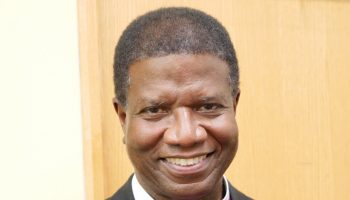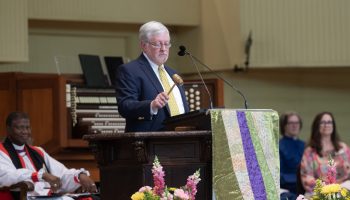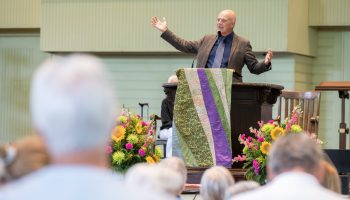
“Who are those people (who hope)? Where do I find them? There are many days I need to make friends with them,” said Sister Teresa Maya. “Every 25 years, there is a jubilee year, and I wonder why Pope Francis called this the Jubilee Year of Hope when the times are so uncertain and people’s hearts are breaking.”
Sister Teresa preached at the 9:15 a.m. Friday morning worship service in the Amphitheater. The title of the sermon was “Those Who Hope,” and the scripture reading was Isaiah 40:21–31.
The former pope titled the convocation “Hope Does Not Disappoint.” Sister Teresa said, “He has a strange sense of humor. Then he said, ‘Everyone knows what it is to hope.’ Do we? How do we know it when we are looking for it?”
Pope Francis opened the Vatican door for the jubilee on Christmas Eve. “When he opened it, I feared he would not be here to close it. For the first time in centuries, another pope will close it. This was not the first time he would start something that he could not finish,” she said. “I was skeptical when he called a global consultation to make the church more relational. He appointed women to high posts and talked about migrants.”
Pope Francis started many things he could not finish, but Sister Teresa remembered his first encyclical, The Joy of the Gospel. In it, he wrote that time is greater than space and that we all should be able to work without immediate results, that we should accept the tension between fullness and limitation.
“Could it be that Pope Francis knew he would begin many processes that he would not finish?” Sister Teresa asked the congregation. “He understood that we must refocus in a way that Isaiah understood — this is God’s work. Isaiah said, ‘The Lord is the everlasting God, / the Creator of the ends of the earth. / He does not faint or grow weary; his understanding is unsearchable.’ ”
She recalled her second visit to the Basílica de la Sagrada Família in Barcelona. When the only modernist architect who was a believer was interviewed about why he began a project he could not possibly see to the end, he responded: “I know the personal taste of the architects that follow me will influence the works. But that doesn’t bother me.” Sister Teresa said, “I think the Temple will benefit from it. Great temples have never been the work of just one architect.”
She continued, “We have to trust the future. The heart of the teaching is that time is greater than space. Hope is about more than our selves, our strengths, our failings and our lifetimes. Hope is impossible without faith. Pope Benedict taught that faith is the substance of hope. Hope is what happens when you have run out of optimism, options and platitudes.”
In a review of The Spirit of Hope, by author Byung-Chul Han, the reviewer quoted this line: “Only in the deepest despair does true hope arise. The deeper the despair, the more intense the hope.”
Sister Teresa admitted that the line had given her hope. When we try to run away from despair, we run into trouble, she told the congregation. “The only way to get hope is by going through the despair; it is the only way to greater union with God. Hope is a long narrative. It is a sentinel scouting the horizon. As Byung-Chul Han says, ‘Hope is a searching movement. It ventures into what is not yet.’ ”
The journey to hope is a journey of courage, and we don’t need it if there is no cost to our activism, she said, quoting theologian Bryan Massingale. “Courage is required precisely because the struggle — as Martin Luther King expressed — is long, bitter but beautiful.”
She continued, “We will be overwhelmed every time, but hope is the opposite of fear. Hope is fear tamed. I kept a fortune from a fortune cookie which says, ‘Don’t sit around waiting for inspiration; begin and inspiration will find you.’ ”
Hope also needs community. Isaiah wrote to a community that “hope unites and makes us communities a dimension of our lives. Hope needs friends. Hope comes from God. We need the patience of eternity for us to believe and hope in what we are doing.”

Sister Teresa Maya, a member of the Congregation of the Sisters of Charity of the Incarnate Word in San Antonio, opens her sermon series last Sunday in the Amphitheater. Von Smith/ Staff Photographer
Sister Teresa shared a poem given to her by Jill, a chaplain of chaplains at the Catholic Health Association.
“Hope Is Not a Bird, Emily, It’s a Sewer Rat”
By Caitlin Seida
Hope is not the thing with feathers
That comes home to roost
When you need it most.
Hope is an ugly thing
With teeth and claws and
Patchy fur that’s seen some shit.
It’s what thrives in the discards
And survives in the ugliest parts of our world,
Able to find a way to go on
When nothing else can even find a way in.
It’s the gritty, nasty little carrier of such
diseases as
optimism, persistence,
Perseverance and joy,
Transmissible as it drags its tail across
your path
and
bites you in the ass.
Hope is not some delicate, beautiful bird,
Emily.
It’s a lowly little sewer rat
That snorts pesticides like they were
Lines of coke and still
Shows up on time to work the next day
Looking no worse for wear.
Sister Teresa said, “May we all be communities of hope.” The congregation gave her a sustained standing ovation and applause.
The Rev. Scott Maxwell presided. Jane McCarthy, who leads the Women in Ministry discussion and the 10:15 a.m. Service of Blessing, read the scripture. The prelude was “There is a balm in Gilead,” arranged by Robert J. Powell, performed by Laura Smith, organ scholar, on the Massey Memorial Organ. The anthem, sung by the Motet Choir, was “Come, Let us Anew,” music arranged by Mack Wilberg and words by Charles Wesley. The choir was under the direction of Joshua Stafford, director of sacred music and the Jared Jacobsen Chair for the Organist, and accompanied by Owen Reyda, organ scholar, on the Massey organ. Stafford performed “Toccata” from Symphony No. 5 by Charles-Marie Widor for the postlude. Support for this week’s chaplaincy and services was provided by the Reverend Leonard J. Ebel Chaplaincy.




